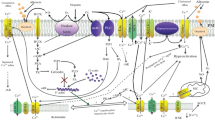Abstract
Calmodulin regulates a wide variety of cellular functions by interacting with its binding proteins or enzymes 1. Based on studies with a number of naturally occuring peptides that bind calmodulin with high affinity, it has been predicted that both ionic and hydrophobic interactions are involved in the association and that a general characteristic of a calmodulin-binding peptide is the ability to form a basic, amphiphilic helix 2–5. Indeed as the sequence of calmodulin-binding proteins have become known, the basic, amphiphilic helix has been shown to be the one common feature of the calmodulin-binding domain 6–16.
Access this chapter
Tax calculation will be finalised at checkout
Purchases are for personal use only
Preview
Unable to display preview. Download preview PDF.
Similar content being viewed by others
References
A.R. Means, Rec., Prog. Horm. Res. 44:223 (1988).
J.A. Cox, M. Comte, J.E. Fitton, and W.F. DeGrado, J. Biol. Chem. 260:2527 (1985).
L. McDowell, G. Sanyal, and F.G. Prendergast, Biochemistry 24:2979 (1985).
D.P. Geidroc, T.M. Keravis, J.V. Staros, N. Ling, J.N. Wells, and D. Puett, Biochemistry 24:1203 (1985).
D.A. Malencik, and S.R. Anderson, Biochem. Biophys. Res. Commun. 114:50 (1983).
W.F. DeGrado, S. Erickson-Viitanen, H.R. Wolfe, Jr. and K.T. O’Neil, Proteins 2:20 (1987).
D.K. Blumenthal, K. Takio, A.M. Edelman, H. Charbonneau, K. Titani, K.A. Walsh, and E.G. Krebs, Proc. Natl. Acad. Sci. USA 82:3187 (1985).
V. Guerriero, Jr., M.A. Russo, N.J. Olson, J.A. Putkey, and A.R. Means, Biochemistry 25:8372 (1986).
T.J. Lukas, W.H. Burgess, F.G. Prendergast, W. Lau, and D.M. Watterson, Biochemistry 25:1458 (1986).
R.M. Hanley, A.R. Means, T. Ono, B.E. Kemp, K.E. Burgin, N. Waxham, and P.T. Kelly, Science 237:293 (1987).
C.R. Lin, M.S. Kapiloff, S. Durgerian, K. Tatemoto, A.F. Russo, P. Hanson, H. Schulman, and M.G. Rosenfeld, Proc. Natl. Acad. Sci. USA 84:5962 (1987).
M.K. Bennett, and M.B. Kennedy, Proc. Natl. Acad. Sci. USA 84:1794 (1987).
B. Buschmeier, H.E. Meyer, and G.W. Mayr, J. Biol. Chem. 262:9454 (1987).
P. James, M. Maeda, R. Fischer, A.K. Verma, J. Krebs, J.T. Penniston and E. Carafoli, J. Biol. Chem. 263:2905 (1988).
G.E. Shull, and J. Greeb, J. Biol. Chem. 263:8646 (1988).
K.A. Alexander, B.T. Wakim, G.S. Doyle, K.A. Walsh, and D.R. Storm, J. Biol. Chem. 263:7544 (1988).
T. Ono, Y. Koide, Y. Arai, and K. Yamashita, J. Biol. Chem. 259:9011 (1984).
T. Ono, Y. Koide, Y. Arai and K. Yamashita, J. Biochem. (Tokyo) 98:1455 (1985).
Y. Koide, T. Ono, and K. Yamashita, Cell Calcium 7:329 (1986).
T. Ono, Y. Koide, Y. Arai and K. Yamashita, Arch. Biochem. Biophys. 255:102 (1987).
Y. Koide, T. Ono, C. Ishinami, and K. Yamashita, Amer. J. Physiol. 250:C299 (1986).
J.M. Sikela, and W.E. Hahn, Proc. Natl. Acad. Sci. USA 84:3038 (1987).
J. Kyte, and R.F. Doolittle, J. Mol. Biol. 157:105 (1982).
J. Gamier, D.J. Osquthorpe and B. Robson, J. Mol. Biol. 120:97 (1978).
S.K. Hanks, A.M. Quinn and T. Hunter, Science 241:42 (1988).
Author information
Authors and Affiliations
Editor information
Editors and Affiliations
Rights and permissions
Copyright information
© 1989 Plenum Press, New York
About this chapter
Cite this chapter
Ono, T., Means, A.R. (1989). Calspermin is a Testis Specific Calmodulin-Binding Protein Closely Related to Ca2+/Calmodulin-Dependent Protein Kinases. In: Hidaka, H., Carafoli, E., Means, A.R., Tanaka, T. (eds) Calcium Protein Signaling. Advances in Experimental Medicine and Biology, vol 255. Springer, Boston, MA. https://doi.org/10.1007/978-1-4684-5679-0_29
Download citation
DOI: https://doi.org/10.1007/978-1-4684-5679-0_29
Publisher Name: Springer, Boston, MA
Print ISBN: 978-1-4684-5681-3
Online ISBN: 978-1-4684-5679-0
eBook Packages: Springer Book Archive




